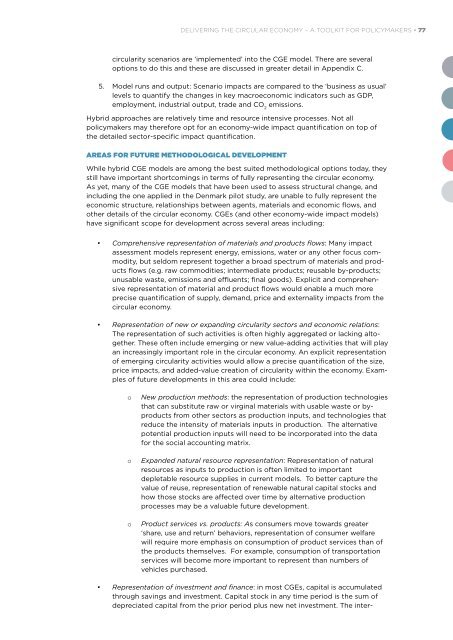DELIVERING THE CIRCULAR ECONOMY A TOOLKIT FOR POLICYMAKERS
20150924_Policymakers-Toolkit_Active-links
20150924_Policymakers-Toolkit_Active-links
You also want an ePaper? Increase the reach of your titles
YUMPU automatically turns print PDFs into web optimized ePapers that Google loves.
<strong>DELIVERING</strong> <strong>THE</strong> <strong>CIRCULAR</strong> <strong>ECONOMY</strong> – A <strong>TOOLKIT</strong> <strong>FOR</strong> <strong>POLICYMAKERS</strong> • 77<br />
circularity scenarios are ‘implemented’ into the CGE model. There are several<br />
options to do this and these are discussed in greater detail in Appendix C.<br />
5. Model runs and output: Scenario impacts are compared to the ‘business as usual’<br />
levels to quantify the changes in key macroeconomic indicators such as GDP,<br />
employment, industrial output, trade and CO 2<br />
emissions.<br />
Hybrid approaches are relatively time and resource intensive processes. Not all<br />
policymakers may therefore opt for an economy-wide impact quantification on top of<br />
the detailed sector-specific impact quantification.<br />
AREAS <strong>FOR</strong> FUTURE METHODOLOGICAL DEVELOPMENT<br />
While hybrid CGE models are among the best suited methodological options today, they<br />
still have important shortcomings in terms of fully representing the circular economy.<br />
As yet, many of the CGE models that have been used to assess structural change, and<br />
including the one applied in the Denmark pilot study, are unable to fully represent the<br />
economic structure, relationships between agents, materials and economic flows, and<br />
other details of the circular economy. CGEs (and other economy-wide impact models)<br />
have significant scope for development across several areas including:<br />
• Comprehensive representation of materials and products flows: Many impact<br />
assessment models represent energy, emissions, water or any other focus commodity,<br />
but seldom represent together a broad spectrum of materials and products<br />
flows (e.g. raw commodities; intermediate products; reusable by-products;<br />
unusable waste, emissions and effluents; final goods). Explicit and comprehensive<br />
representation of material and product flows would enable a much more<br />
precise quantification of supply, demand, price and externality impacts from the<br />
circular economy.<br />
• Representation of new or expanding circularity sectors and economic relations:<br />
The representation of such activities is often highly aggregated or lacking altogether.<br />
These often include emerging or new value-adding activities that will play<br />
an increasingly important role in the circular economy. An explicit representation<br />
of emerging circularity activities would allow a precise quantification of the size,<br />
price impacts, and added-value creation of circularity within the economy. Examples<br />
of future developments in this area could include:<br />
o<br />
o<br />
o<br />
New production methods: the representation of production technologies<br />
that can substitute raw or virginal materials with usable waste or byproducts<br />
from other sectors as production inputs, and technologies that<br />
reduce the intensity of materials inputs in production. The alternative<br />
potential production inputs will need to be incorporated into the data<br />
for the social accounting matrix.<br />
Expanded natural resource representation: Representation of natural<br />
resources as inputs to production is often limited to important<br />
depletable resource supplies in current models. To better capture the<br />
value of reuse, representation of renewable natural capital stocks and<br />
how those stocks are affected over time by alternative production<br />
processes may be a valuable future development.<br />
Product services vs. products: As consumers move towards greater<br />
‘share, use and return’ behaviors, representation of consumer welfare<br />
will require more emphasis on consumption of product services than of<br />
the products themselves. For example, consumption of transportation<br />
services will become more important to represent than numbers of<br />
vehicles purchased.<br />
• Representation of investment and finance: in most CGEs, capital is accumulated<br />
through savings and investment. Capital stock in any time period is the sum of<br />
depreciated capital from the prior period plus new net investment. The inter-



